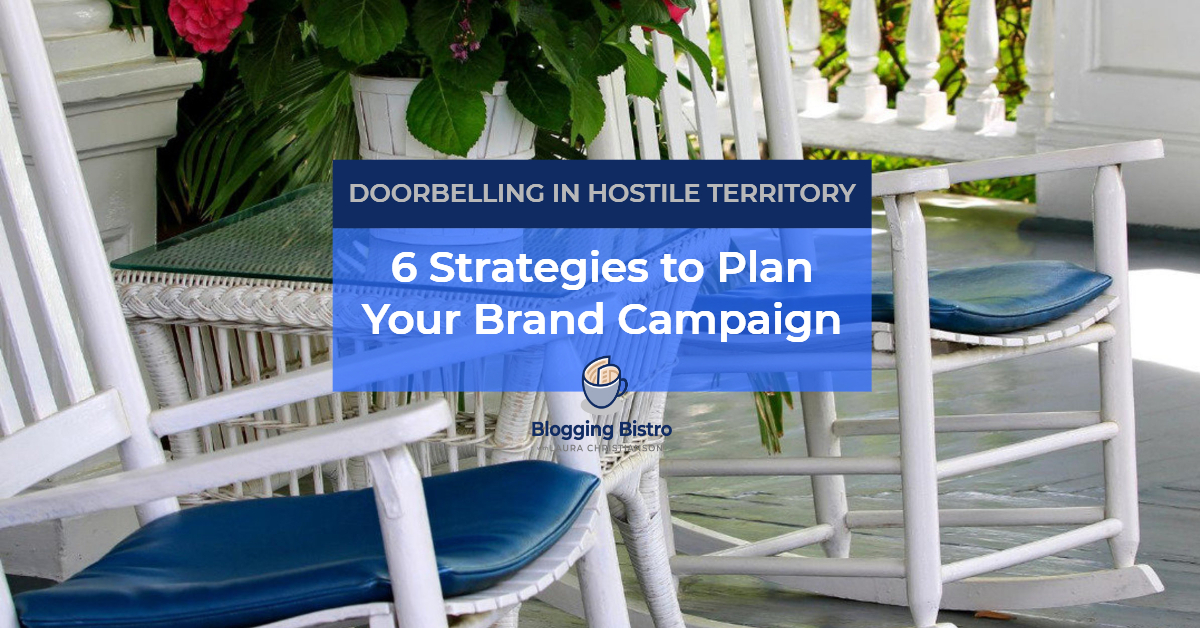29 – Doorbelling in Hostile Territory: 6 Strategies to Plan Your Brand Campaign

I was Swiffering my kitchen floor Saturday morning when I heard a firm knock on the front door. Thinking it might be one of our sons making an unannounced visit, I answered the door.
There was a normal-looking middle-aged guy standing 6 feet away. I asked myself,
Is this one of my neighbors whom I haven’t met?
He’s not dressed like a Mormon missionary.
Is he delivering something? But there’s no delivery van in front of my house.
He introduced himself and said he is running for Congress.
A quick aside: In Washington state, we had a primary election August 4. In our state, the top two vote-earners, regardless of their political party, get on the ballot for the general election.
I congratulate him for his primary win, and as I do, I’m frantically thinking, What Congressional district am I in? Who did I vote for? Did I vote for this guy? Who’s running against him? What political party does he represent?
He hands me a brochure, which I unwisely accept from his outstretched hand – the man isn’t wearing a mask.
He delivers a quick spiel: “I’m a business owner; I live in a neighboring town.”
OK; I can relate to that.
Then he adds, “I don’t like the way things are being run by our government in Washington D.C., so that’s why I decided to run.”
Now I’m thinking, This guy must be a Democrat because he’s saying he doesn’t like the way our government is being run, and a Republican is currently the president of our country.
I speed-read his red, white, and blue pamphlet while he says, “I was wondering if you have any questions you’d like to ask me.”
I’m still distracted, thinking, Where’s my Voter’s Pamphlet so I can check to see who I voted for? Why is this guy not wearing a face mask when he’s knocking on the doors of everyone in town during a pandemic?
I discern from his pamphlet that he’s a Republican. Now I’m bewildered. The man just told me he doesn’t like the way “the government in Washington D.C. is being run.” But he’s a Republican, which means that he likely supports our current president. In my mind, “government” and “president” are holding hands; maybe even hugging each other.
I realize I actually do have a question.
“Are you a Trump supporter?” I ask.
This podcast is a politics-free zone, so I’m not going to share his response, or my response to his response.
But I will say that this candidate honestly and forthrightly answered my question, and I appreciated his honesty.
5 Things the Doorbeller Did that We Can Apply to Growing Our Own Business
The point I want to make relates to the techniques we use when reaching out to potential new fans, followers, or, in the case of this person running for Congress, voters.
Let’s look at what this doorbeller did, and then we’ll apply it to our own brand.
1. He put himself out there.
He believes that changes need to be made, and he believes he has the skills and experience to make change happen. He has strong convictions – strong enough to put his name on a public ballot and go door-to-door during a pandemic to meet voters.
2. He took a huge risk by entering potentially hostile territory.
I live in the most populated and politically liberal region of Washington state. While the voters in my suburban/rural county are more moderate than in neighboring Seattle, their political views (whether left, right, or in between) tend to be sharply defined.
This man told me that he hadn’t visited my neighborhood before the primary, so he probably didn’t have a clear picture (on a house-by-house basis), of where my neighborhood stands, politically (we’re all over the map; I can tell you that much).
Before he started knocking on doors, he knew he would face intense opposition, challenges to his beliefs, hostility, people swearing at him, dogs being sicced on him, and doors slamming in his face.
And yet, there he was, all by his lonesome, meeting and greeting. That took an extra measure of courage, or bravado, or stupidity, depending on your perspective.
3. He introduced himself concisely, and he came across as relatable and approachable.
He started by succinctly stating his name. He reminded me of our recent primary election and shared that he’d made the top two.
He did this in a couple of sentences, which was perfect for me. He knew his audience would be a homeowner who was relaxing or cleaning their house on a Saturday morning, and he didn’t want to waste my time, but rather, to help me put his face with his name.
When he finished his 2-sentence intro, he paused and gave me a chance to respond. In turn, I congratulated him for earning a spot on the ballot.
He then gave me a few more pertinent details: he told me what town he lives in and that he’s a 30-year-business owner.
My initial response was, As a fellow long-time business owner, I can relate to that. You seem solid. Respectable. Show me what else ya got.
4. His brand message was “me-focused.”
Here’s where things went haywire for me. After the initial introduction and quick warmup, he made a “me” statement instead of a “you” statement. This is so critical in brand messaging, and it’s where the vast majority of us mess up.
He said, “I don’t like the way things are being run by our government in Washington D.C.”
Instead of answering a question for me, his statement initiated doubt in my mind. WHY doesn’t he like the way things are being run? What “things” is he referring to? What political party does he represent?
He didn’t tell me when he introduced himself. Why didn’t he tell me? His political affiliation seems important, particularly in light of his dissatisfaction with the government.
Now, instead of feeling warm and fuzzy, I began to have doubts about this person. Can I trust him? What isn’t he telling me? Why isn’t he forthcoming about these things? Why is he telling me what he doesn’t like instead of what he does stand for?
5. He didn’t give me enough context to ask intelligent questions.
This person did what’s called “interruption marketing” or “cold calling,” where he interrupted my brain-fogged Saturday morning with a message I wasn’t mentally prepared to process.
Word Nerd Moment
We interrupt this podcast to define interruption marketing: You broadcast a message to a wide audience – many of whom are not your ideal target audience – and capture their attention by interrupting what they’re doing, seeing, or thinking.
Interruption marketing typically requires a lot of resources – advertising dollars, or, in this case, the human resource of time spent doorbelling. Because people find interruption marketing annoying, it traditionally has a low return-on-investment (ROI).
Because his brand message was “me-focused” instead of “you-focused,” when he paused and asked if I had any questions, my brain scrambled to come up with appropriate questions to ask him.
As a result, I got stuck in the weeds. I kept mentally asking myself, What political party does he represent? Why doesn’t he like the way the government is being run?
I needed to have those basic questions answered and to hear his stance on specific important issues in order to have a fruitful conversation with him. Because he didn’t give me that basic information up front, I lost trust in him.
Action Steps: 6 Strategies to Help You Plan Your Brand Campaign
Let’s apply this situation to the way we do business.
Like this candidate for Congress, we all have strengths and weaknesses in the way we reach out to our audience, particularly when we’re attempting to connect with a “cold” audience – that is, people who have never heard of us.
For the next few minutes, imagine you’re a candidate for office. Not political office, but you’re trying to get “voted in” for the brand message you represent. You’re doorbelling in a neighborhood that might react with hostility to your message.
Here are 6 strategies to help you plan your campaign.
During the next section of Episode #29, I’ll verbally walk you through the questions. Print your workbook and as you listen, jot down your initial responses in your workbook.
Strategy #1: Put yourself out there.
- Related: Episode #3: Going All In
Strategy #2: Boldly enter hostile territory.
Related:
- Episode #5: Is a B-Minus Launch Good Enough?
- Episode #23: Dealing with Rants, Ridicule, and Crushing Criticism
Strategy #3: Introduce yourself concisely, in a relatable manner.
Strategy #4: Focus on meeting your audience’s needs.
Related:
- Episode #14: Everyone’s Favorite Radio Station – Are You Tuned In?
- On-Demand Audio Training and Workbook: Find Your Ideal Target Audience
Strategy #5: Instill trust.
Related:
- Episode #2: How to Act Like a Professional (Even When You Don’t Feel Like One)
- Episode #10: Moving from Self-Focused to Self-Forgetful
Strategy #6: Invite your audience to take the next step with you.
Your Assignment
How will you shape your message to gain the trust of the people you hope to serve?
After jotting down your initial responses to the questions, put your workbook aside for a couple of days.
Then listen to/read Episode #29 again and revisit the questions.
Rinse and repeat as often as you need to.
Ready?
Set?
Go!
How to Keep Up With the Show
Click here to join my my email list and I’ll notify you about every episode. (When you subscribe, you’ll also get my free guide, Essential Resources for Running a Writing Business.)
Join The Professional Writer Podcast Community (private Facebook group), where we discuss what we’re learning, meet our guests, and encourage one another on our writing journeys.
If you know a writer who would be interested in The Professional Writer Podcast, please share this link with them:
https://bloggingbistro.com/podcast
Thank you!
Laura

